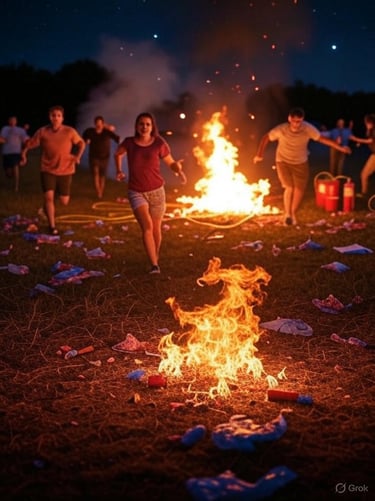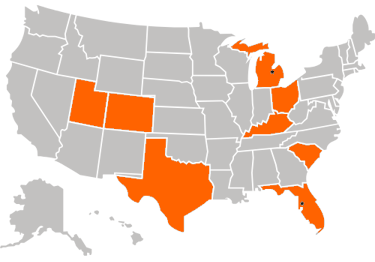Firework Safety: Celebrating Independence Day Responsibly
As the Fourth of July approaches, the excitement of fireworks lights up the night sky across the United States. While these dazzling displays are a cherished tradition, they come with significant risks if not handled properly. Fireworks can ignite brush fires, house fires, and vehicle fires, causing property damage, injuries, and even fatalities. By understanding the dangers and following safety guidelines, you can enjoy a festive and safe Independence Day celebration. This blog post explores the fire hazards associated with fireworks, shares critical statistics, and provides practical tips for responsible firework use.


The Risks of Fireworks: Fire Hazards in Focus
Fireworks are a leading cause of fires in the United States, particularly around Independence Day. According to the National Fire Protection Association (NFPA), fireworks start an estimated 18,500 fires annually, including 1,300 structure fires, 300 vehicle fires, and 16,900 outdoor and other fires. These incidents result in approximately $43 million in direct property damage each year. The Fourth of July is the peak day for firework-related fires, accounting for more than half of the fires reported on that day compared to any other day of the year. In 2022, the NFPA reported 12,264 fires caused by fireworks, with 2,082 structure fires, 316 vehicle fires, and 9,866 outdoor fires, leading to 29 civilian injuries and $59 million in property damage.
The risk is heightened during the summer months due to dry conditions, especially in regions experiencing drought. For example, in 2022, Missouri reported that 93.3% of the state was abnormally dry or in drought, increasing the likelihood of grass and brush fires sparked by fireworks. Sparklers, often considered safe, burn at temperatures exceeding 1,200°F—hot enough to ignite clothing, dry vegetation, or nearby structures. Mishandling or misfiring fireworks can also lead to catastrophic consequences, such as house fires when embers land on rooftops or in gutters, or vehicle fires when sparks ignite flammable materials.
Firework-Related Injuries: A Sobering Reality
Beyond property damage, fireworks pose a significant risk of injury. In 2024, the U.S. Consumer Product Safety Commission (CPSC) reported 11 fireworks-related deaths and an estimated 14,700 injuries treated in emergency rooms, a 38% increase in deaths and 52% in injuries compared to 2023. Approximately 66% of these injuries occurred in the four weeks surrounding July 4th, with burns (42%) being the most common, particularly to hands and fingers (35%) and the head, face, and ears (22%). Sparklers alone accounted for 1,700 emergency room visits in 2024, underscoring their deceptive danger. Young men and adolescent boys are particularly at risk, making up over 70% of fireworks-related injuries.
Enjoying Fireworks Safely: Tips for a Responsible Celebration
The safest way to enjoy fireworks is to attend professional displays conducted by trained experts. However, if you choose to set off consumer fireworks, following strict safety protocols can minimize risks. Here are practical tips to ensure a safe and responsible Independence Day celebration:
Know Local Laws: Before purchasing fireworks, confirm they are legal in your area. Some states, like Illinois, restrict consumer fireworks, while others, like Missouri, allow sales from June 20 to July 10. Always buy from licensed retailers and ensure fireworks are labeled for consumer use.
Choose a Safe Location: Use fireworks in a clear, open space free of flammable materials like dry grass, leaves, or debris. Avoid areas near buildings, vehicles, or wooded areas to prevent brush or structure fires. Maintain a minimum distance of 150 feet from structures for aerial fireworks.
Keep Water and Safety Equipment Nearby: Have a garden hose, bucket of water, or fire extinguisher readily available to extinguish small fires or douse used fireworks. Soak all fireworks in water for at least 20 minutes after use before discarding them to prevent smoldering embers from igniting trash or other materials.
Light Fireworks Responsibly: Light one firework at a time and move back quickly to a safe distance. Never lean over a firework while lighting it, and avoid pointing or throwing fireworks at people or property. Wear safety glasses and ear protection, and tie back long hair or loose clothing to prevent burns.
Handle Duds with Care: If a firework fails to ignite, do not attempt to relight or handle it. Wait at least 20 minutes, then soak it in water before disposal to prevent accidental ignition.
Supervise Children Closely: Never allow young children to handle fireworks, including sparklers, which can cause severe burns. If teens are permitted to use fireworks, ensure adult supervision and adherence to safety guidelines. Consider safer alternatives like glow sticks or confetti poppers for young children.
Stay Sober: Avoid using fireworks while under the influence of alcohol or drugs, as impaired judgment increases the risk of accidents.
Monitor Environmental Conditions: Check weather forecasts for high winds, low humidity, or drought conditions, which can exacerbate fire risks. Postpone firework use if conditions are unsafe, as sparks can easily ignite dry vegetation or structures.
Protect Your Property: Clear dry shrubs, grass, and debris from around your home before using fireworks. Ensure rooftops and gutters are free of flammable materials, as embers can smolder and ignite hours after landing. Even Class A fire-rated roofing materials may not fully protect against firework hazards if debris is present.
Be Mindful of Others: Fireworks can trigger distress for individuals with post-traumatic stress disorder (PTSD) or disturb pets. Notify neighbors in advance and limit firework use to reasonable hours to minimize community impact.
Alternatives to Consumer Fireworks
For those looking to reduce risks while still enjoying the festive spirit, consider attending professional firework displays or exploring alternatives like drone light shows, which are gaining popularity as a safer, environmentally friendly option. Glow sticks, confetti poppers, and colored streamers provide fun, kid-safe ways to celebrate without the fire hazards. These alternatives eliminate the risk of fires and injuries while maintaining the celebratory atmosphere.
Conclusion: Celebrate Safely This Fourth of July
Independence Day is a time for joy, community, and celebration, but safety must come first. Fireworks cause thousands of fires and injuries each year, with a significant spike around July 4th. By choosing professional displays, following local regulations, and adhering to safety guidelines, you can protect your family, property, and community. Let’s make this Fourth of July a memorable and safe celebration for everyone.
For more information on firework safety, visit the U.S. Consumer Product Safety Commission or the National Fire Protection Association. Stay safe and have a happy Independence Day!




